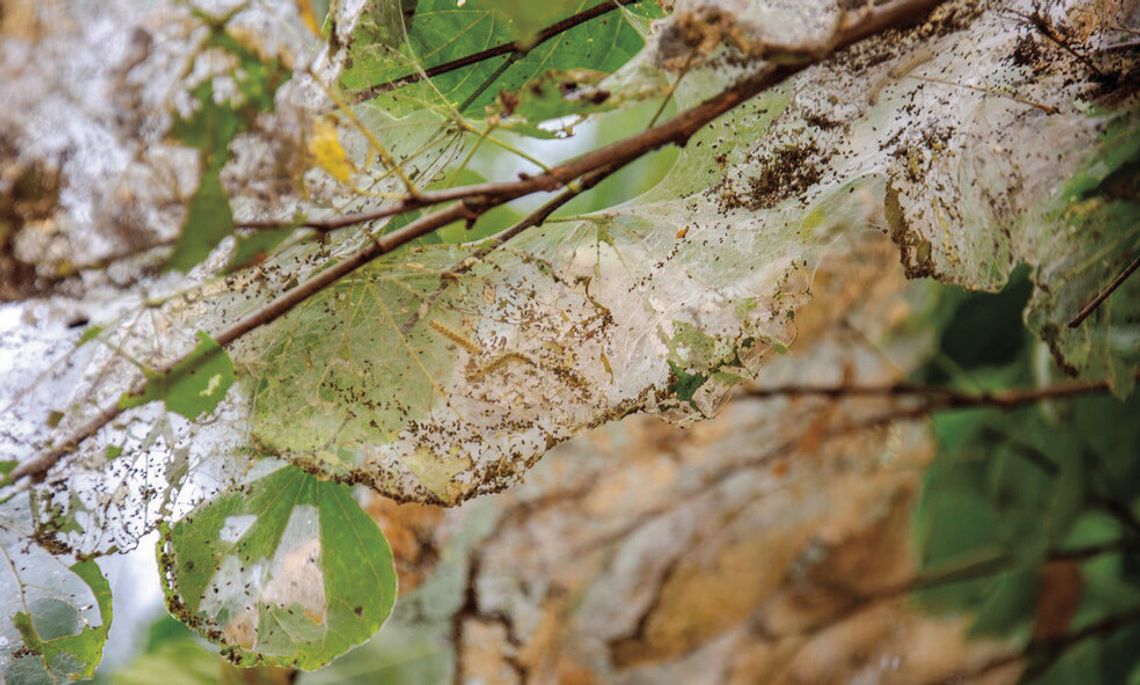University of Illinois Extension Webs in trees: The Life and Impact of Fall Webworms
There are many ways we mark the ‘end of summer’. Some refer to the beginning of school or the closing of the pool, while others view Labor Day as the ‘unofficial end of summer’. Another way, if you’re more entomologically inclined, is the appearance of fall webworm.
Fall webworm (Hyphantria cunea) ‘nests’ often start becoming noticeable in our landscapes during the late summer and early fall. The caterpillars will spin their communal webs on the ends of branches on which they are feeding. They have been found on over 400 different species of trees and shrubs. In Illinois, they are most commonly found on crabapple, walnut, hickory, pecan, redbud, sweetgum, maple, and oak.
What do fall webworms look like?
There are two races of caterpillars. The black-headed race has, as the name implies, a black-head. Their bodies are yellowish with a dark stripe on the back, and long white hairs rising from black bumps. The red-headed race has a red head with a yellowish-tan body and brownish hair that arises from reddish-brown bumps.
Fall webworm life cycle
Fall webworms will begin to emerge in the summer. The females will lay egg masses that contain several hundred eggs on the undersides of leaves. About seven days later, the larvae (caterpillars) will hatch.
The caterpillars will spin a silk web over the leaves as they feed and will remain inside the webbing. As they exhaust their food supply, they will continue to enlarge the webbing. After feeding for around 4 to 6 weeks, the caterpillars will leave the webbing and spin a cocoon in leaf litter or bark crevices to pupate.
Managing fall webworm
In most cases, only a branch here or there will be attacked. Occasionally, though, entire branches, or trees in extreme cases, can be stripped of leaves if populations get high enough. As alarming as it may be, it’s unlikely to do any longterm damage to established trees.
The primary problem with fall webworm is aesthetics. If you just can’t stand the sight of them, or if you have a newly planted tree being attacked, there are several things you can do.
One common way of managing them is to prune the affected branches out of trees. Keep in mind that the webbing is only temporary; any pruning you do will be permanent and can potentially hurt the aesthetics of the plant.
Webs can be removed manually, either by hand, using a stick, or some other device.
The water-resistant webbing that fall webworms create makes it difficult to control them with pesticides. If pesticides are used, use enough pressure to penetrate the webbing or tear it open before spraying. Keep in mind that any chemical used may have an impact on any predators and parasitoids that may attack the fall webworm.
You can also let nature take its course. At least 50 species of parasitoids and dozens of predators have been found to attack fall webworm, which is why populations are often cyclical (pest populations build up, natural enemies move in, and pest populations fall).
Good Growing Fact of the Week: Fall webworm and eastern tent caterpillar are often confused with one another. Eastern tent caterpillars are out earlier in the year (spring), create webbing in the forks and crotches of trees, and will leave their webs to feed.









